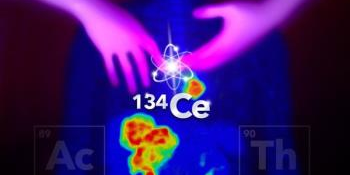New Imaging Isotope Meets Promising Therapy Isotopes

Image courtesy of Donald Montoya, Los Alamos National Laboratory Cerium-134 can be targeted to provide an imaging analogue for two different therapy isotopes, actinium-225 and thorium-227. This helps scientists understand these therapy isotopes and develop new treatments. These novel isotopes are being developed and produced by the DOE Isotope Program.
The Science
A multidisciplinary team has demonstrated the production, purification, and potential application of cerium-134. This isotope decays into lanthanum-134, an isotope useful for positron emission tomography (PET) imaging. PET imaging uses radioactive substances to visualize and measure processes in the body. It is an essential tool in diagnosing disease and monitoring treatment. The team demonstrated the use of cerium-134 for PET imaging in mice. The results show that cerium-134, through its lanthanum-134 decay product, could serve as a diagnostic partner for medical treatments based on actinium-225 or thorium-227.




